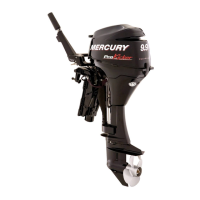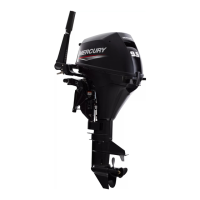Do you have a question about the Mercury 9.9 EH and is the answer not in the manual?
Explains how to transfer the limited warranty to a subsequent purchaser for the remainder of its duration.
Details the process and requirements for registering your product's warranty in the US and Canada.
Outlines the procedure for warranty registration for customers outside the US and Canada.
Covers the limited warranty for new products sold in specific regions, detailing what is covered.
Specific warranty coverage for corrosion damage on new outboards, inboards, and jet drives.
Clarifies common misunderstandings about warranty, listing covered repairs and general exclusions.
Outlines the operator's responsibilities for safe operation, including reading the manual and ensuring passenger safety.
Emphasizes reading the manual, understanding operation, and using common sense for safety.
Warns about exceeding the boat's maximum horsepower rating and its potential consequences.
Specifies that remote control systems must have a start-in-neutral protection device for safety.
Advises on using proper fasteners and procedures for steering link rod connections to prevent control loss.
Explains the function of the lanyard stop switch to shut off the engine in case of operator ejection.
Provides safety advice on operating the boat in water where people might be present, especially around propellers.
Addresses passenger safety on pontoon and deck boats, cautioning against standing in unsafe areas.
Discusses the hazards associated with operating a boat over waves and wakes, especially during jumps.
Advises caution in shallow water or areas with suspected underwater obstacles to prevent damage and injury.
Provides specific safety guidance for operating hand-tilled outboards, particularly regarding seating positions.
Alerts to the dangers of carbon monoxide poisoning from engine exhaust and emphasizes ventilation.
Recommends using genuine Mercury accessories and checking compatibility before installation.
Offers general advice on boating safety, including regulations, flotation devices, and load limits.
Instructs owners to record the engine's serial number for reference, theft, and identification purposes.
Provides instructions for mounting the outboard motor onto the boat's transom, emphasizing correct procedures.
Guides on installing remote control cables and boxes, recommending dealer consultation.
Details the proper mounting and connection procedures for the starting battery, emphasizing safety.
Advises on choosing the correct propeller for optimal performance, ensuring engine RPM is within the recommended range.
Steps for safely disconnecting and removing the outboard motor from the boat.
Instructions on how to carry the outboard motor, emphasizing vertical posture and head height.
Guidelines for storing the outboard motor, recommending vertical posture.
Procedures for securely trailering the boat with the outboard, including tilt position and securing devices.
Safety warnings and instructions for transporting portable fuel tanks, focusing on ventilation and fire prevention.
Specifies acceptable gasoline types, octane ratings, and warnings against improper fuel use.
Discusses the use of oxygenated gasolines in the USA and their acceptability for Mercury engines.
Details potential adverse effects of alcohol in gasoline on engine components and performance.
Recommends specific NMMA certified TC-W3 2-Cycle oils and alternatives for engine lubrication.
Provides the correct fuel-to-oil mixing ratios for break-in and normal operation.
Outlines the critical engine break-in process, including fuel mixture and operating variations.
Instructions and warnings for safely filling fuel tanks, emphasizing ventilation and not overfilling.
Describes the functions and operation of the remote control system, including handle, lever, and switches.
Explains the basic operation of tilting the outboard motor up and down for shallow water or full up positions.
Provides safety precautions for operating the outboard in shallow water, advising slow speeds and tilting.
Details how to adjust the trim angle for optimal performance, stability, and steering effort.
Explains how to adjust steering friction using the steering co-pilot for desired control.
Guides on adjusting the friction of the throttle grip for maintaining desired speed.
Describes how to adjust the trim tab to compensate for steering torque and reduce unequal steering effort.
A comprehensive list of essential checks before starting the outboard engine for safe operation.
Advises on precautions for operating or storing the outboard in freezing conditions to prevent water damage.
Recommends flushing the outboard with fresh water after use in saltwater or polluted water to prevent corrosion.
Discusses potential adjustments needed for operating the outboard at higher elevations due to reduced air density.
Provides guidance on using the outboard as an auxiliary power source, including restraint during use.
Step-by-step instructions for preparing the engine before starting, including fuel connection and primer bulb use.
Details the critical engine break-in process, including oil mixture, duration, and throttle variations.
Explains the importance of warming up the engine before operation to ensure proper lubrication and longevity.
Provides instructions for starting electric start and manual start engines, including pre-checks and battery connection.
Instructions on safely shifting the outboard between forward, neutral, and reverse gears at appropriate engine speeds.
Procedures for safely shutting down the engine for both 9.9/15/18/EH and E models.
Instructions for starting the engine using a spare starter rope if the electric start system fails.
General advice on maintaining the outboard for optimal condition, safety, and dependability.
Recommends using genuine Mercury or Quicksilver parts and lubricants for maintenance.
Provides a schedule of regular inspections and maintenance tasks based on usage intervals.
Details the process of flushing the cooling system with fresh water after use in saltwater or polluted water.
Instructions for safely removing and reinstalling the outboard's top cowl for access to internal components.
Guidance on inspecting the battery for proper engine starting capability and ensuring secure connections.
Covers fuel system inspection, including fuel lines, primer bulb, and fuel filters, with safety warnings.
Step-by-step guide for safely removing and installing the outboard propeller, including warnings.
Instructions for inspecting, cleaning, gapping, and replacing spark plugs for optimal engine performance.
Advises on lubricating specific points on the outboard, recommending authorized service shops and genuine parts.
Step-by-step instructions for draining and refilling the gearcase lubricant to ensure proper lubrication.
Emphasizes the need for immediate professional service for submerged outboards to prevent corrosion damage.
Checks to perform on the battery and shift/throttle functions before placing the outboard in storage.
Procedures for preparing the outboard for out-of-season or prolonged storage to prevent rust and damage.
Addresses fuel system preparation for storage, including fuel stabilization and draining to prevent issues with alcohol content.
Guidance on protecting external parts from corrosion and damage during storage, including lubrication and paint touch-ups.
Steps to protect internal engine parts during storage, involving fuel system prep, flushing, and cylinder sealing.
Instructions for draining and refilling the gearcase lubricant as part of storage preparation.
Recommends storing the outboard in an upright position to allow water drainage, avoiding tilted positions.
Advice on storing the battery, including checking levels, recharging, and maintaining charge.
Lists common causes for an electric start engine failing to crank, such as blown fuses or battery issues.
Provides potential causes for the engine failing to start, including fuel delivery issues, switches, and spark plugs.
Identifies possible reasons for the engine running rough or inconsistently, such as fouled spark plugs or fuel restrictions.
Lists factors that can lead to reduced engine performance, including throttle, propeller, and engine load.
Outlines common causes for a battery failing to retain its charge, such as loose connections or an inefficient battery.
Emphasizes returning the outboard to an authorized dealer for service due to their expertise and tools.
Guidance on contacting the nearest authorized dealer or Mercury Marine Service Office when away from the local dealer.
Directs inquiries about genuine parts and accessories to the authorized dealer, requiring model and serial numbers.
Steps for resolving issues or concerns with the outboard product, involving dealership contact and Mercury Marine support.
A template to record all performed maintenance, encouraging saving work orders and receipts.
A table listing propeller sizes and their recommended applications for different boat types and models.
Lists service tools, spare parts, and other associated components included with or recommended for the outboard.
Electrical wiring diagram for Mercury outboard models 9.9, 15, and 18.
Electrical wiring diagram specifically for the EH model outboards.
Electrical wiring diagram for the E model outboards, showing component connections.
Wiring diagram for the single remote control box, illustrating connections for switches and indicators.
A table defining the standard wire color codes used in the wiring diagrams for clear identification.
| Steering | Tiller |
|---|---|
| Engine Type | 2-cylinder |
| Power | 9.9 hp |
| Fuel Type | Petrol |
| Full Throttle RPM Range | 5000-6000 |
| Gear Shift | Forward, Neutral, Reverse |
| Exhaust | Through Prop |












